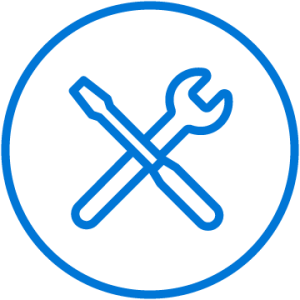Custom Development Software Factory
The Custom Development Software Factory comes into play when the software requirements are unique and distinct, which cannot be aptly met through re-use nor through the standardized offerings of SaaS or PaaS.

Share this
Custom Solutions for Custom Needs
The Custom Development Software Factory (CustomDev) is tailored to VA’s unique software needs, ensuring modern, maintainable solutions.
This segment of the SWF relies on a holistic platform approach, providing teams with a comprehensive set of tools, including cloud hosting services, Continuous Integration/Continuous Delivery (CI/CD) pipelines, and additional support functions. Fundamental to CustomDev is its focus on detailed documentation, getting started guides, 1-click deployment for test bed environment(s), shared engineering standards & best practices, and much more. By having these items in place, CustomDev helps promote transparency and ensures that each software delivery platform is scalable and can adapt to future technologies.

Internal Developer Resources
Requires VA network access.
CODE VA (Catalog of Developer Essentials) is the starting point for all VA software developers — contractors and federal employees — providing relevant technical documentation and self-service activation for shared services and approved software delivery platforms. The developer portal includes platform quick start guides, machine configuration tips/tricks, easy integration pattern(s) with APIs, and more.
Developer PortalSWF Certified Custom Development Platforms
In 2023, the CustomDev team prioritized development platforms that streamline the creation and hosting of products with an integrated suite of tools, cloud services, and CI/CD pipelines. A new assessment and certification process now evaluates these platforms, ensuring a base level of quality. Platforms are assessed on overall quality of service and their performance in the five phases of the software development lifecycle - plan, develop, test, deploy, monitor & operate.
Benefits Integration Platform
The Benefits Integration Platform (BIP) provides VA projects with the efficiency, accuracy, and security they require for seamless integration with reusable services. Furthermore, it consists of modern, scalable, and cloud-based IT infrastructure and a set of high-quality tools that guide project teams through a collaborative network of services. For more information, see the BIP SharePoint Site.
Lighthouse Delivery Infrastructure
The Lighthouse Delivery Infrastructure (LHDI) platform provides a suite of infrastructure, tools, and development guidelines that enable rapid and secure development, deployment, and operation of high-quality VA APIs and other custom applications within the VA Enterprise Cloud (VAEC). A core component of the LHDI platform is the Secure Release (SecRel) Pipeline – which enables development teams to rapidly create a continuous Authorization To Operate (cATO) under the NIST Risk Management Framework. For more information on LHDI’s cATO, see the playbook and for documentation see the LHDI Developer Documentation.
VA.gov Platform
The VA.gov Platform is the common infrastructure, technical and non-technical components, and processes that support static and interactive content consumed by Veterans via VA.gov. Major pieces of the Platform include a set of APIs that manage communication between a Veteran end user and internal VA resources, an identity and authentication system, the VA.gov Design System, reusable frontend components, a Drupal-based content management system, and an extensive set of documentation and guides. For documentation, see the VA.gov Platform Developer Documentation.
VA Platform One
VA Platform One (VAPO) delivers and manages an integrated platform solution with a focus on agility, automation, scale, and appropriate development autonomy. This solution is based on a containerization approach that provides a pathway for traditionally hosted applications to leverage cloud native services, auto-scaling, and repeatable continuous integration/continuous deployment (CI/CD) processes. For more information, see the VAPO SharePoint Site.
Frequently Asked Questions
For someone managing a custom product that people would call legacy, how does that fit into the factory model space?
Each case may be different, but no one is being forced to only use the four platforms that exist. There will likely be many examples or use cases where the legacy system or application that’s been built and we’re still leveraging and supporting is going to continue in the fashion that it’s been in. There may be opportunities to leverage certain utilities or other services that the SWF Model can provide without changing development platforms at large.
How will you ensure that developers are aware of and effectively using the portal you’re creating?
The quality of the content that is published plays a big role in making it a place that people want to go. The team is looking at the communication strategy and plan to figure out how to communicate the developer portal better when it goes live. There will be many other forms of communication coming in the near future about the portal. There will also be metrics taken as well to determine where the most value is being provided to the developers and the people accessing the portal.
Will this work with the Technical Reference Model (TRM) or will it replace the TRM?
Ideally, the work being completed here is complemented by the TRM and other tooling that exists. There may be opportunities in the future to conduct user research on how people interact with the TRM or expose the TRM as an API – but no plans have been discussed at length.



